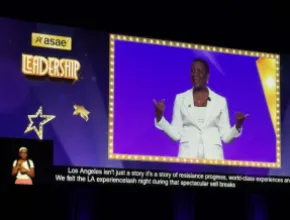While the economy has not dealt the same kind of body blow to association meetings as it has to those on the corporate side, that doesn’t mean that associations are unscathed. Keeping attendance figures up at the annual convention in a year when many members have less time and money to spare is a daunting challenge for many organizations.
At the same time, meeting planners have more ways to market and promote conventions than ever before. In particular, some planners are finding that social media such as Facebook, LinkedIn and Twitter have unbounded potential to create buzz and excitement about upcoming events.
To get a handle on how associations are dealing with today’s attendance challenges, Meetings MidAmerica spoke with a cross-section of association executives, planners and consultants.
What impact is the economy having on attendance at annual conventions?
John Graham, president and CEO, ASAE & The Center for Association Leadership, Washington, D.C.: Most people I’m talking to say things are soft—with attendance down 15 to 20 percent on average. Some are down as far as 30 or 40 percent. It really depends on the sector; the American Diabetes Association had great numbers this year. On the exhibit side, we’re seeing the same number of exhibitors, but a smaller footprint at the meeting.
Stephen Carey, lead strategist, Association Management + Marketing Resources, Bethesda, Md.: If you’ve got an industry that’s hard hit by the economy, things will be down whether you’ve got a good show or not. A large association—a trade group hit by the different forces out there—went from 100,000 to 60,000 in attendance this year from last. However, we have a client in the wind energy business that’s growing by leaps and bounds. They’re having trouble finding large enough venues.
Lynne Tiras, president, International Meeting Managers, Houston: We haven’t seen a big drop yet, but I’m anxious about what will happen in 2010. So far the meetings we’ve had were on the mark. Since the majority of our clients are medical, we’re somewhat insulated. They do continuing education and so people need to attend for this.
Karl Kirsch, vice president, Meeting Expectations, Atlanta: Associations tend to lag behind the economy because people tend to register six to nine months in advance. Some have been devastated and some are doing better than ever. On average, we’re seeing about a 10 to 15 percent drop in attendance.
Amy Drum Caruso, president, Drum Consultants, Wyncote, Pa.: The numbers may be down, but the quality is high. You may not send as many people from one office; you may target who’s going. Leaders and decision-makers are going. A lot of it comes down to T&E costs and getting approval for travel expenditures, especially the later you get in the year. People are watching their year-end expenditures.
Steven Drake, president, Drake & Co., Chesterfield, Mo.: Most attendance is down, but a few are up. Some national conventions are cutting back on the number of days. We have one going from a three-night stay this year to two nights in 2010. It’s not just about the hotel cost, but about being away. People are very time-sensitive now.
What is being emphasized in promoting the convention—has content, particularly sessions that address career survival issues, become more important as a draw for attendance?
Graham: It’s all about communicating why it’s important to go to the meeting. Clearly now it’s important that the association put out there what the attendee can get out of the meeting. Most attendees have to justify to their bosses why they have to go to the meeting, so you have to be aggressive in making sure they have the ammunition.
Carey: With attendance-building, everything boils down to the value equation. What is it that will get my member to get on an airplane or in a car to get to the meeting? Number one is the education program. Number two is the networking that can take place. Education and networking that turn business leads into dollars are they two motivators there. All the other things at the meeting—keynote speakers, the exhibit program—are secondary. Content is the value equation.
Drake: It’s the topic and the content that drives attendance. If you don’t have topics that interest people, they won’t come. Content trumps location as well as big-name speakers. And, as we face the uncertainty of the economy, it’s important to be flexible with the program so you can address what’s on people’s minds at the moment. We need speakers who are prepared to change their topics, if the need arises.
John McKennon, president, Meeting Management Services, Washington, D.C.: The feel-good speeches are gone. How you can survive in today’s marketplace is tops. You have to be current and you can’t be guessing. You have to have the best experts to pass on their insight—and people will show up.
Terrance Barkan, chief strategist, Globalstrat, Alexandria, Va.: It’s all about quality content that gives people something they can really use or that will facilitate business to be done. It is not enough to offer “talking heads” or thinly disguised marketing presentations. Often, too many presentations disappoint the audience because they over promise and under deliver. Think about what problem you are trying to solve for your attendees and get speakers and content that delivers solutions, not teaser presentations that leave the audience disappointed. High-priced keynotes are great to listen to, but I always question the ROI.
How big a role are websites and social media playing in generating interest in the annual convention?
Kirsch: Way back you could just mail out the brochure, then came faxes and then e-mail was the silver bullet. Social media is another platform. You have to use them all. Some people will want the brochure, some will want to be invited through Facebook. We’re advising associations to find where their members are already. Business groups may be more adept at LinkedIn, while social groups may prefer Facebook. Spend your time where your members are. If an association is not investigating the new media, they will fall behind.
Drake: More and more, we’re seeing clients who don’t do any print at all. Some of our members are 55 years of age on average—and even they do mostly electronic. It not only saves on paper, but on cost. Postage is high.
We are using Twitter, Facebook and LinkedIn a lot. I recommend to all our clients that they at least get their name on all three of these. It’s like the race for domain names on the Internet—you’ve got to protect your brand.
Graham: There’s been a huge shift to social media. You’ll have people on Twitter during the sessions, tweeting people who aren’t at the meeting as well as those who are. Social media is being used to promote the meeting and the meetings website. It’s all about building up that viral buzz.
What the social media channels do is allow you to form your own Facebook or LinkedIn experience within your own association. We’re doing this with our membership directory now. Our membership directory allows you to post your picture and profile. You can befriend members. All of this stuff is a game changer in how we communicate.
Rick Dungey, executive director, Midstates Hearth, Patio & Barbecue Association, Chesterfield. Mo.: Websites, e-mail blasts and other e-communication add a lot of flexibility to meeting promotions. You don’t have to wait for all speakers to get their bios in before sending out a registration brochure. You can send out what you have and post updates online. It gives you a great reason to send another promotion to attendees: “New Speaker Just Added!” You can’t do that economically with printed pieces.
What impact has the economy had on regional meetings?
Dungey: Small-business owners are really watching their spending budgets, and if they can’t justify the expense of going to the national convention, they are asking for a regional replacement. Or at least something similar where they can get high-level continuing education and see some new products from manufacturers and suppliers.
Barkan: Regional meetings are a smart choice today. There has always been a significant potential audience that would like to attend a live event, but the time commitment for long-distance travel and the cost prevents them from attending. Regional meetings garner new attendees, and I have yet to see them reduce attendance at the main event.
Kirsch: The regional meetings are becoming more important; not because people aren’t going to national meetings, but because the associations have to diversify their revenue. If they’re 10 percent off on the national convention, they have to make it up. The national convention remains the premier forum for education, but regional meetings are less expensive and you can still get the CEUs. It depends what you can talk your boss into.
How big a factor is the destination in driving attendance? Is it more or less of a challenge to promote a second-tier city rather than a first-tier? What aspects of a destination seem most important to attendees these days?
Graham: What second-tier cities are experiencing now is a renaissance. They are much more attractive than they were, and they are doing well because of perception issues. It’s a lot easier to say I have to attend a meeting in St. Louis, Dallas, Minneapolis or Nashville than it is to say Miami or Las Vegas right now. Associations are less concerned with public perception than corporations, but at the end of the day someone has to justify the expenditure to a boss or a board. At the same time, if you’re in a city with glamorous appeal, it’s even more incumbent on you to amplify the education component.
McKinnon: Associations are concerned about perception, but many conventions have booked so far out that you can’t do much about it. If we booked Disney World five years ago, it will be at Disney World. But we are going back and renegotiating with facilities to get the best value possible—and we let people know they are getting a good value.
Tiras: Next to content, site selection is the second largest factor in driving attendance. We’re still using resorts—and going in high season. Resorts are still the biggest draw, especially if people want to combine a meeting with a vacation and take their families. This is happening more often. In March, we had a medical conference in Hawaii, with almost 1,000 attendees, including 150 children. Resorts everywhere are looking for business, so it’s a good time to use them. We’re booking 2011 and 2012 now. There seems to be good deals even that far out.
Dungey: Very few small-business owners are bringing their families to conventions anymore, so area points of interest or activities really aren’t important. I think the most important thing is how easy it is to get to a place: flight schedules, airline ticket prices and rental car rates seem to be the most important factors. ?







